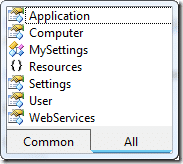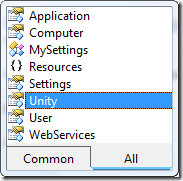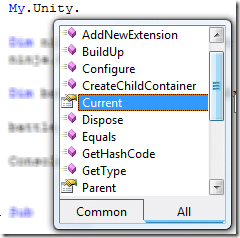I have been attempting to integrate the Unity Application Block into my website to allow me to share the same base object code between a WPF and an ASP.NET application. I will let you know how I am getting along later as I am still knee deep in refactoring, but I have found something a little useful.
I have created a custom “My” object in Visual Studio. This means that I can do “My.Unity.Container” to retrieve my UnityContainer object form anywhere is my code. I know it my be trivial to achieve in other ways, but I am a VB degenerate having fun, so leave me alone…
The first thing we need is a way of consistently creating a singleton instance of our UnityContainer across all of our code in the AppDomain.
Imports Microsoft.Practices.Unity
Public Class UnityContainer
Inherits Microsoft.Practices.Unity.UnityContainer
Private Shared sm_UnityContainer As Microsoft.Practices.Unity.UnityContainer
Private Shared sm_syncRoot As New Object
Private Sub New()
MyBase.New()
End Sub
Public Shared ReadOnly Property Current() As Microsoft.Practices.Unity.UnityContainer
Get
If (sm_UnityContainer Is Nothing) Then
SyncLock sm_syncRoot
If (sm_UnityContainer Is Nothing) Then
sm_UnityContainer = New UnityContainer
'Dim section As UnityConfigurationSection = ConfigurationManager.GetSection("unity")
'section.Containers.Default.Configure(sm_UnityContainer)
End If
End SyncLock
End If
Return sm_UnityContainer
End Get
End Property
End Class
I have commented the lines out, but you could also initialise the Unity Container from a config file, but remember that it will be the top level config of your application root an not the config from the Assembly that you code happens to be in.
We could just leave it at that, and If you use C# this is about your lot, but in VB you have the “My” namespace that gives you access to some useful things all in one place.
In order to achieve this you need to create a Module in the “My” namespace that has a single property that access the previous class.
Imports Common
Namespace My
<HideModuleName()> _
Module MyUnityExtensions
Friend ReadOnly Property Unity() As UnityContainer
Get
Return UnityContainer.Current
End Get
End Property
End Module
End Namespace
This the allows you to access the UnityContainer object in the same way that you would access My.User.
Inside the Unity object you will have all of the shared properties and methods that we created earlier.
To examine the use of this I have followed O1eg Smirnov’s Ninja Dependency Injection scenario.
So, I have a Console application that registers a sword type and the resolves out a Ninja Object using Unity.
Imports NinjaCommon
Module Module1
Sub Main()
' Register Weapon
My.Unity.RegisterType(Of IWeapon, Sword)()
'Create Ninja
Dim ninja = My.Unity.Resolve(Of Ninja)()
' Ninja uses weapon
ninja.Weapon.use()
' Create Battle
Dim battle As New NinjaClasses.Battle
' Start the fight
battle.StartFight()
Console.ReadKey()
End Sub
End Module
But it then instantiates a Battle class from the NinjaClasses assembly which uses it own My.Unity class to access the same UnityContainer object.
Public Class Battle
Public Sub New()
End Sub
Public Sub StartFight()
Console.WriteLine("Fight Starting ")
' Create 10 ninjas and get them to use their weapon.
For count = 1 To 10
Dim ninja = My.Unity.Resolve(Of NinjaCommon.Ninja)()
ninja.Weapon.use()
Next
Console.WriteLine("Fight ended")
End Sub
End Class
Although this example in no way demonstrates the power of the Unity Application Block, and is a bit silly, I think it demonstartes the use of the “My” namespace.




